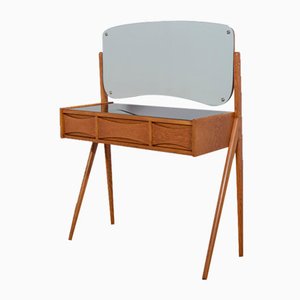
Arne Vodder was born in Denmark in 1926. Trained as a cabinetmaker and architect, he studied under Finn Juhl at the Royal Danish Academy of Fine Arts in Copenhagen, graduating in 1947. After school, he worked as a designer at Hindsgaul in Copenhagen, focusing primarily on office décor. In 1950, Vodder launched his own architecture and design studio with architect Anton Borg. Over the years, the studio moved to a few locations within Copenhagen before ultimately settling in the suburb of Holte, north of the city. Together, the two designed furniture as well as several low-cost houses. Vodder and Borg collaborated until the 1970s.
Vodder is best known for his furniture designs, which tended to be simple pieces composed of natural materials such as rosewood and teak, often inspired by the natural forms, and occasionally accented with colorful panels. Vodder worked with several respected brands throughout his career, designing cabinetry, tables, seating, and more for furniture makers Fritz Hanson, France & Søn, Nielaus, Sibast, Kircodan (for which he designed garden furniture), as well as the department store Havemanns Magasin A/S (for which he designed the interiors), among others.
While Vodder is less well known today than some of his contemporaries, his work was well received throughout his lifetime. In fact, between the 1950s and ’70s, Vodder’s furniture designs were used by President Jimmy Carter in the White House and President Anwar Sadat in Cairo, and were also included in the United Nations Office in Geneva, as well as in a number of hotels, banks, and embassies worldwide. His work was exhibited widely both individually and in group exhibitions with the likes of Verner Panton and Nanna Ditzel.
Vodder passed away in 2009.

